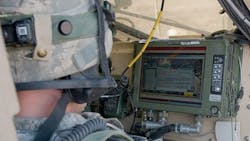SOSA flexes its muscles, eyes common ground among open-systems standards for military embedded computing
THE MIL & AERO COMMENTARY – Open-systems industry standards for embedded computing are making another run at the aerospace and defense market, and this time it looks like they're for real.
This latest set of standards like the Sensor Open Systems Architecture (SOSA) is steadily gaining traction in the Pentagon and in the defense business because everybody's on board -- the government as well as industry.
The potential benefits of standard electronic architectures seem like a no-brainer: component interoperability, rapid innovation, quick technology insertion, reduced costs to the taxpayer, and the ability for defense systems to keep up with the cutting edge of commercial computer technology.
Still, attempts to formulate open-systems standards for electronics over the past three decades typically have fallen short. The reason is they have been pushed by just one side or the other -- government or industry. This time everyone's working together, and this time it looks like it's going to happen.
The linchpin is SOSA, the newest in the latest crop of open-systems electronics standards, and one that borrows heavily from the OpenVPX embedded computing standard of the VITA Open Systems and Open Markets trade group in Oklahoma City. SOSA has gained industry appeal by winnowing-down the large number of standards outlined in OpenVPX to a relatively small number manageable to the military.
What sealed it for SOSA is the so-called Tri-Service Memo, signed one year ago by the secretaries of the U.S. Navy, Army, and Air Force. The memo mandates SOSA and several other standards for all future military requirements in weapon system modification and new-start development programs to the maximum extent possible.
In addition to SOSA, the Tri-Service Memo mentions the Future Airborne Capability Environment (FACE); Hardware Open Systems Technologies (HOST); Vehicular Integration for C4ISR/EW Interoperability (VICTORY); and Open Mission Systems/Universal Command and Control Interface (OMS/UCI). Other new or emerging open-systems standards of influence to the military include Command, Control, Communications, Computers, Intelligence, surveillance and Reconnaissance (C4ISR) / Electronic Warfare (EW) Modular Open Suite of Standards (CMOSS); and Modular Open RF Architecture (MORA).
Not only have the military services voiced their support for SOSA, but each service sends representatives to SOSA standards-formation committees. This gives the military a voice, side-by-side with industry, in how SOSA standards develop.
Related: Open-systems standards like SOSA could promote genuine embedded computing interoperability
Many consider SOSA to be the most dominant and influential of these standards not only because of its military-wide support, but also because its administration comes under The Open Group in San Francisco -- an industry consortium in place to promote open, vendor-neutral technology standards and certifications. Until SOSA, the latest standards typically have been military service-specific or platform-specific initiatives.
HOST, for example, saw its beginnings and initial support at U.S. Naval Air Systems Command. VICTORY comes from the Army combat electronics community, FACE primarily is a military avionics project, OMS/UCI is an Air Force project, and MORA came out of the Army Communications-Electronics Research, Development and Engineering Center (CERDEC) at Aberdeen Proving Ground, Md.
Although SOSA seems to have the most influence, it's doubtful that SOSA will evolve into a multi-service, multi-platform, one-size-fits-all standard that will absorb all the others.
Instead, SOSA seeks primarily to find common ground, rather than to dominate. The SOSA effort seeks to find what's common in SOSA, FACE, HOST, CMOSS, VICTORY, OMS/UCI, MORA, and potentially others. Those common guidelines will serve not only as a foundation for future military solicitations and standards development, but also to align these standards such that substantial differences stay at a minimum.
The goal, ultimately, is to craft SOSA, FACE, HOST, CMOSS, VICTORY, OMS/UCI, MORA so that these standards are at least 80 percent common. That way, a company that has invested in aligning its products to one standard, can conform to the other standards quickly and easily by making only minor tweaks.
In other words, it's no longer necessary to jump onto one standards bandwagon to the exclusion of all the others. Companies should be able to choose any of these standards for their technology and product development, knowing that they will be at least 80 percent aligned with all the others.
With this kind of top- and mid-level support, government and industry are marching forward together -- finally -- to craft the high-performance electronic systems of the future.
About the Author
John Keller
Editor-in-Chief
John Keller is the Editor-in-Chief, Military & Aerospace Electronics Magazine--provides extensive coverage and analysis of enabling electronics and optoelectronic technologies in military, space and commercial aviation applications. John has been a member of the Military & Aerospace Electronics staff since 1989 and chief editor since 1995.
